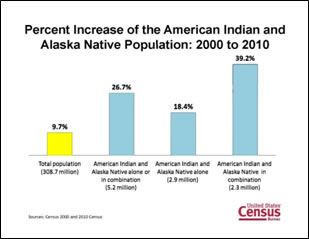end of header
Newsroom Archive
Release Information
Contact: Public Information Office
301-763-3030/3762 (fax)
FOR IMMEDIATE RELEASE: WEDNESDAY, JAN. 25, 2012
2010 Census Shows Nearly Half of American Indians and Alaska Natives Report Multiple Races
The U.S. Census Bureau today released a 2010 Census brief, The American Indian and Alaska Native Population: 2010, [PDF] that shows almost half (44 percent) of this population, or 2.3 million people, reported being American Indian and Alaska Native in combination with one or more other races. This multiracial group grew by 39 percent from 2000 to 2010.

Overall, 5.2 million people, or 1.7 percent of all people in the United States, identified as American Indian and Alaska Native, either alone or in combination with one or more races. This population grew by 27 percent from 2000 to 2010. Those who reported being American Indian and Alaska Native alone totaled 2.9 million, an increase of 18 percent from 2000 to 2010. The multiple race American Indian and Alaska Native population, as well as both the alone and alone-or-in-combination populations, all grew at a faster rate than the total U.S. population, which increased by 9.7 percent from 2000 to 2010.
More Than Three-Fourths Live Outside Tribal Areas
A majority of the American Indian and Alaska Native alone-or-in-combination population (78 percent) lived outside of American Indian and Alaska Native areas. At the same time, most counties with relatively higher proportions of American Indians and Alaska Natives tended to be in close proximity to reservations, trust lands or Oklahoma tribal statistical areas. This was especially evident in counties throughout the West and in Oklahoma.
Majority Live in 10 States
The 10 states with the largest American Indian and Alaska Native alone-or-in-combination population in 2010 were California, Oklahoma, Arizona, Texas, New York, New Mexico, Washington, North Carolina, Florida and Michigan. Among these states, Texas, North Carolina and Florida experienced substantial rates of growth in this population at 46 percent, 40 percent and 38 percent, respectively. The American Indian and Alaska Native alone population experienced growth of at least 20 percent in Texas, North Carolina, Florida and New York.
The multiple-race American Indian and Alaska Native population increased by more than 50 percent in 18 states. North Carolina, Delaware and South Dakota experienced the most rapid growth in this population at more than 70 percent. In all but three states, the multiple-race proportion of the American Indian and Alaska Native alone-or-in-combination population increased from 2000 to 2010.
Tribal Groupings
The largest number of people who identified with an American Indian tribal grouping, either alone or in combination, identified as Cherokee (819,000). The Navajo tribal grouping had the largest number of individuals who identified with one tribal grouping and no other race (287,000).
Among the largest American Indian tribal groupings, Blackfeet had the highest proportion who reported more than one tribal grouping or race. Seventy-four percent of Blackfeet individuals reported an additional race and/or tribal grouping.
The largest Alaska Native tribal grouping, either alone or in combination, was Yup'ik (34,000), followed by Inupiat (33,000). Yup'ik also had the greatest number of people who identified with one tribal grouping and no other race (29,000).
Among all Alaska Native tribal groupings, Tlingit-Haida had the highest proportion who reported more than one tribal grouping or race. Forty-two percent of Tlingit-Haida individuals reported an additional race and/or tribal grouping.
Race Definitions
People who reported only one race on their 2010 Census questionnaire are referred to as the race “alone” population. For example, respondents who marked only the “American Indian or Alaska Native” category would be included in the American Indian and Alaska Native alone population. This population can be viewed as the minimum number of people reporting American Indian and Alaska Native.
Individuals who chose more than one of the six race category options on the 2010 Census form are referred to as the race "in combination" population, or as the group who reported more than one race. One way to define the American Indian and Alaska Native population is to combine those respondents who reported American Indian and Alaska Native alone with those who reported American Indian and Alaska Native in combination with one or more other races. Another way to think of the American Indian and Alaska Native alone-or-in-combination population is the total number of people who reported American Indian or Alaska Native, whether or not they reported any other races.
Follow @uscensusbureau on Twitter, Facebook, Flickr, YouTube and Ustream.
Comments or suggestions?




